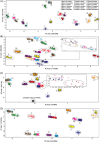A Review of Analytical and Chemometric Strategies for Forensic Classification of Homemade Explosives
- PMID: 40242023
- PMCID: PMC12002426
- DOI: 10.1002/ansa.70010
A Review of Analytical and Chemometric Strategies for Forensic Classification of Homemade Explosives
Abstract
Homemade explosives (HMEs), commonly used in improvised explosive devices (IEDs), present a significant forensic challenge due to their chemical variability, accessibility and adaptability. Traditional forensic methodologies often struggle with environmental contamination, complex sample matrices and the non-specificity of precursor residues. Recent advances in analytical techniques and chemometric methods have enhanced the detection, classification and interpretation of explosive residues. Infrared (IR) spectroscopy and gas chromatography-mass spectrometry (GC-MS) have seen improvements in spectral resolution and real-time detection capabilities, allowing for more accurate differentiation of explosive precursors. Thermal analysis techniques, such as thermogravimetric analysis (TGA) and differential scanning calorimetry (DSC), now provide refined kinetic modelling to assess the decomposition pathways of unstable energetic materials, improving forensic risk assessments. Additionally, x-ray diffraction (XRD) has contributed to forensic material sourcing by distinguishing between industrial-grade and improvised explosive formulations. Chemometric approaches, including principal component analysis (PCA), linear discriminant analysis (LDA) and partial least squares discriminant analysis (PLS-DA), have revolutionized forensic data analysis by improving classification accuracy and enabling automated identification of explosive components. Advanced machine learning models are being integrated with spectral datasets to enhance real-time decision-making in forensic laboratories and portable field devices. Despite these advancements, challenges remain in adapting laboratory-based techniques for field deployment, particularly in enhancing the sensitivity and robustness of portable analytical instruments. This review critically evaluates the latest developments in forensic analytical chemistry, highlighting strengths, limitations and emerging strategies to improve real-world HME detection and classification.
Keywords: chemometric methods; explosive residue detection; forensic analysis; gas chromatography–mass spectrometry (GC–MS); homemade explosives (HMEs); infrared spectroscopy (IR).
© 2025 The Author(s). Analytical Science Advances published by Wiley‐VCH GmbH.
Conflict of interest statement
The authors declare no conflicts of interest.
Figures









Similar articles
-
Propellant's differentiation using FTIR-photoacoustic detection for forensic studies of improvised explosive devices.Forensic Sci Int. 2017 Nov;280:169-175. doi: 10.1016/j.forsciint.2017.09.018. Epub 2017 Oct 6. Forensic Sci Int. 2017. PMID: 29073514
-
Development in the Detection and Identification of Explosive Residues.Forensic Sci Rev. 1992 Jun;4(1):17-49. Forensic Sci Rev. 1992. PMID: 26267286 Review.
-
Trace Detection and Chemical Analysis of Homemade Fuel-Oxidizer Mixture Explosives: Emerging Challenges and Perspectives.Trends Analyt Chem. 2020 Oct;131:10.1016/j.trac.2020.116023. doi: 10.1016/j.trac.2020.116023. Trends Analyt Chem. 2020. PMID: 34135538 Free PMC article.
-
Determination of triacetone triperoxide (TATP) traces using passive samplers in combination with GC-MS and GC-PCI-MS/MS methods.Forensic Sci Int. 2023 Jul;348:111673. doi: 10.1016/j.forsciint.2023.111673. Epub 2023 Mar 29. Forensic Sci Int. 2023. PMID: 37031011
-
Screening of synthetic PDE-5 inhibitors and their analogues as adulterants: analytical techniques and challenges.J Pharm Biomed Anal. 2014 Jan;87:176-90. doi: 10.1016/j.jpba.2013.04.037. Epub 2013 May 6. J Pharm Biomed Anal. 2014. PMID: 23721687 Review.
References
-
- Horrocks A. J., Detata D., Pitts K., and Lewis S. W., “Chlorate‐Based Homemade Explosives: A Review,” WIREs Forensic Science 6, no. 2 (2024): e1506, 10.1002/wfs2.1506. - DOI
Publication types
LinkOut - more resources
Full Text Sources
Miscellaneous
